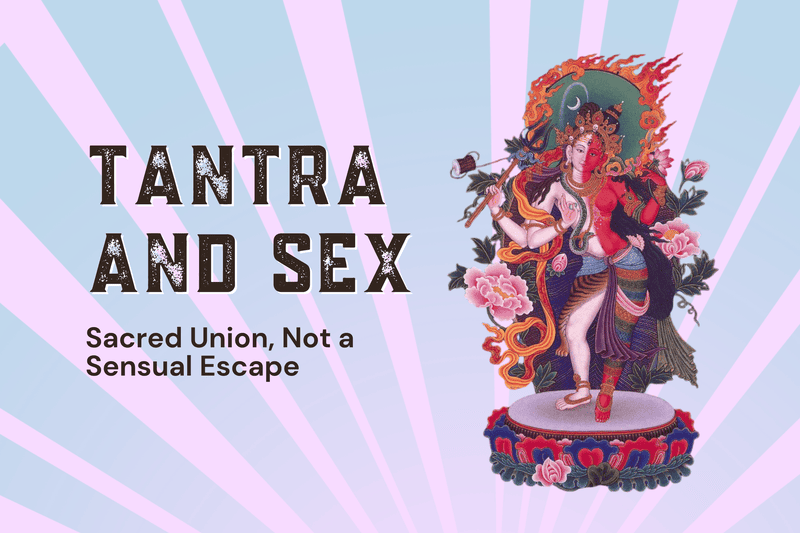In this article, you will read about:
- The Power of the Sri Yantra
- The Creation of the Sri Yantra - Lord Shiva's Gift to the World
- The Geometry and Mathematics of the Sri Chakra Yantra
- The Evolution of Sri Yantra Worship with Sri Vidya
- Worshipping the Sri Yantra - Navavarana Puja
- The Mantras for Worshipping the Sri Yantra
- Das Mahavidyas and the Sri Yantra
- Worshipping the Sri Yantra using the Tantra Sadhana App
In the vast pantheon of sacred symbols that have guided humanity's spiritual quest across millennia, none commands greater reverence or embodies more profound wisdom than the Sri Yantra—the supreme geometric representation of cosmic consciousness and divine feminine power.
This intricate mandala, composed of nine interlocking triangles arranged around a central point, serves simultaneously as a map of the universe, a blueprint of human consciousness, and a powerful tool for spiritual transformation.
The Sri Yantra, also known as Sri Chakra Yantra, represents far more than mere sacred geometry—it is a living spiritual technology that houses within its mathematical precision the complete pantheon of divine consciousness, structured across nine sacred enclosures that mirror the progressive journey of human awareness from material bondage to spiritual liberation.
Each layer contains specific deities, mantras, and spiritual energies that, when properly understood and worshipped, catalyse profound transformation in the practitioner's life and consciousness.
The Power of the Sri Yantra
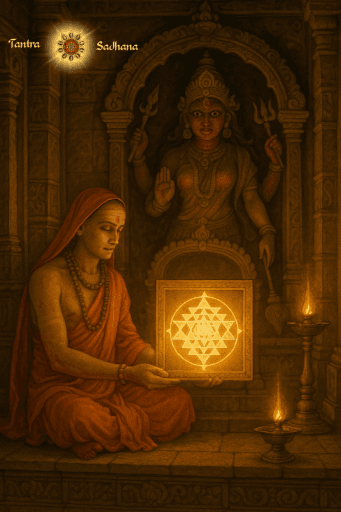
In the 8th century, Adi Shankara was traveling on his mission to unite and revive Sanatana Dharma when he arrived in the holy land of Kanchipuram. Goddess Kamakshi had manifested in an intensely fierce form at the Kanchipuram temple. Her energy had manifested with such ferocity that devotees found it extremely difficult to approach the sanctum for worship. The intense spiritual vibrations created an atmosphere of overwhelming power rather than accessible grace.
According to local legends, the fierce form of Kamakshi would leave the temple during nights to punish or consume those who had incurred her wrath. Adi Shankara's profound spiritual insight enabled him to understand that while the goddess's fierce energy was a legitimate expression of cosmic justice, it needed to be harmonised for the welfare of devotees.
Rather than attempting to suppress or diminish the goddess's power, Shankaracharya sought to balance her fierce aspect with her benevolent, motherly form. He installed a specially consecrated Sri Chakra Yantra directly in front of the main deity. The Sri Chakra Yantra was installed in the trough-like structure within the shrine, positioned to create maximum energetic interaction with the goddess's manifestation.
The Sri Yantra's geometric precision created a regulatory field that could absorb, balance, and redistribute the goddess's intense energy. Instead of overwhelming devotees, the energy became accessible and nurturing. Traditional accounts describe that after the consecration of the Sri Yantra, the fierce form of the goddess became benign (Sowmya).
The transformation was not a suppression but a channeling of the same divine power into a more accessible form. Spiritual adepts believe that the nine interlocking triangles of the Sri Yantra created a resonance field that could harmonize with any form of divine energy.
The installation also represented the union of Shiva (consciousness) and Shakti (energy) in perfect balance. This cosmic harmony transformed the temple into a space where fierce divine justice coexisted with nurturing divine grace.
We find evidence of Adi Shankara's installation of the Sri Chakra Yantra in the Lalitha Trishati Bhashya. You can also find stone inscriptions within the temple that document the installation of the Sri Chakra Yantra.
One of India's greatest sages, Ramana Maharishi, also invoked the remarkable power of the Sri Yantra during the construction of the Mother Temple at Ramanasramam. He took extraordinary personal interest in every detail of the Sri Chakra Yantra installation, personally inscribing sacred bījākṣara mantras on the gold bhūprasthāra yantra that would sit beneath the granite meru.
His meticulous attention to the temple's construction revealed a deep understanding of how sacred geometry can serve spiritual awakening.
The Creation of the Sri Yantra - Lord Shiva's Gift to the World
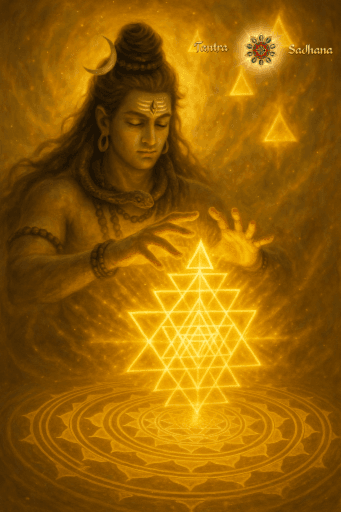
According to ancient tantric tradition, Lord Shiva, as the Adi Guru (primordial teacher) of the tantric sciences, created 64 yantras, along with their corresponding mantras, for the spiritual and material well-being of humanity.
This sacred creation represents a complete system of spiritual technology designed to address every aspect of human existence. Some examples of Yantras include:
- Ganesha Yantra (removing obstacles)
- Kali Yantra (strengthening feminine energy)
- Lakshmi Yantra (material wealth)
- Dhanvantari Yantra (healing)
- Navagraha Yantra (planetary balance)
However, Lord Shiva reserved the most powerful creation—the Sri Yantra—for his divine consort, Shakti. This Sri Yantra was accompanied by the two potent mantras: the Panchadasi (15-syllable) and Shodashi (16-syllable) mantras.
Many scholars suggest that the descriptions within the Sri Suktam, such as the multi-petaled lotus, central point, and references to divine geometry, can be interpreted as references to the Sri Yantra. However, the first unambiguous references and systematic descriptions of the Sri Yantra as a diagram are found in Tantric texts, such as the Brahmanda Purana, the Vamakeshvarimata Tantra, and the Lalita Sahasranama.
The Geometry and Mathematics of the Sri Chakra Yantra
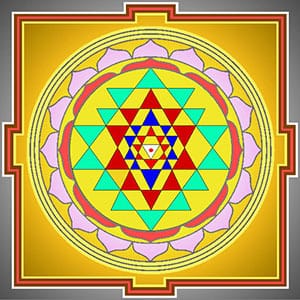
The Sri Yantra's construction represents one of history's most sophisticated achievements in sacred mathematics. This geometric form seamlessly integrates spiritual symbolism with mathematical precision. At its foundation lie nine interlocking triangles: four pointing upward (representing masculine or Shiva energy) and five pointing downward (representing feminine or Shakti energy). These primary triangles intersect to create 43 smaller triangular spaces, each symbolizing specific aspects of cosmic manifestation and human consciousness.
The entire structure radiates from the central bindu—an infinitesimal point representing pure consciousness and the source of all creation. This central dot serves as both the geometric origin and the spiritual destination, embodying the paradox of the absolute: simultaneously the smallest point and the infinite whole from which everything emerges and to which everything returns. Surrounding the triangular core are two concentric rings of lotus petals—16 outer petals representing the physical elements and sensory experiences, and 8 inner petals symbolizing the subtle mental faculties and spiritual qualities. This lotus symbolism reflects the universal spiritual principle of transcendence: just as the lotus rises from muddy waters to bloom in pure sunlight, consciousness can ascend from material entanglement to spiritual enlightenment.
Modern mathematical analysis reveals the Sri Yantra's construction incorporates principles that wouldn't be formally recognized by Western mathematics until centuries later. The Golden Ratio (approximately 1.618) appears throughout the Yantra's proportional relationships, creating the visual harmony and aesthetic perfection that characterizes divine proportion. This same ratio governs growth patterns in nature, from nautilus shells to flower petals, suggesting the Yantra's designers possessed profound insights into universal mathematical principles.
The Fibonacci sequence (0, 1, 1, 2, 3, 5, 8, 13, 21...) manifests in the triangular subdivisions created by the intersecting lines, with each number representing the sum of its two predecessors. This mathematical pattern, later identified by Leonardo Fibonacci in 1202, appears naturally in pine cones, sunflower seed arrangements, and galaxy spiral formations—indicating the Sri Yantra's creators understood mathematics as a language of cosmic order.
Fractal patterns emerge from the Yantra's recursive geometry, where similar triangular forms repeat at different scales, creating infinite depth and complexity within finite boundaries. This characteristic aligns with modern chaos theory and fractal mathematics, suggesting an ancient understanding of mathematical principles that contemporary science has only recently formalized.
The Evolution of Sri Yantra Worship with Sri Vidya
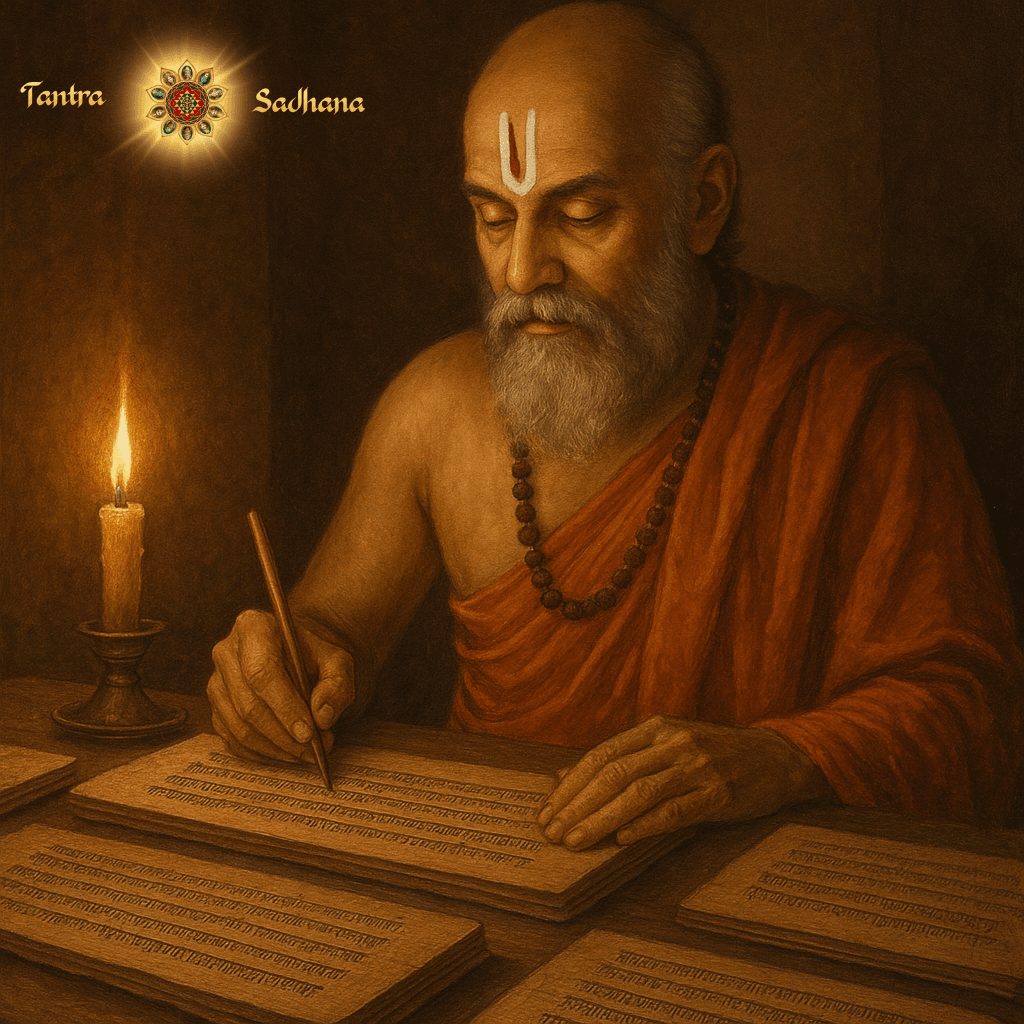
Before formal systematization, Sri Yantra worship existed in various forms across different tantric traditions. Early references can be found in multiple Bhairava Tantras, Rudra Tantras, and Shiva Tantras, where geometric diagrams were employed for specific ritual purposes. The knowledge was primarily transmitted through guru-disciple lineages without systematic textual codification.
One of the first major formalizations of worshipping the Sri Yantra occurred through Kashmir Shaivism, which provided the philosophical foundation for the later development of Sri Vidya.
In the 9th century, the discovery of the Shiva Sutras by Vasugupta marked the beginning of systematic non-dual Shaiva philosophy. These sutras provided the metaphysical framework that would later support Sri Yantra worship as a tool for recognizing divine consciousness. The Spandakārikā introduced the concept of spanda (cosmic pulsation), describing Shakti as the active, creative energy of Shiva. This philosophical foundation became crucial for understanding the Sri Yantra as a representation of cosmic vibration and divine energy. The great philosopher Abhinavagupta created a comprehensive synthesis of Kashmir Shaivism in his Tantraloka. His work provided the theological framework for understanding yantras as tools for pratyabhijñā (divine recognition).
Meanwhile, in the 9th Century, Adi Shankaracharya successfully integrated Sri Vidya practices with Advaita Vedanta, creating a unified non-dual framework. His composition of the Soundarya Lahari provided a devotional and philosophical framework for Sri Yantra meditation by combining bhakti (devotion) with jñāna (knowledge). He also systematically installed Sri Chakras in major temples across India, creating a network of energetically balanced sacred spaces. This practical application demonstrated the Yantra's effectiveness as spiritual technology.
The 10th to 15th centuries saw the emergence of texts that became the core for Sri Vidya and the worship of the Sri Yantra. The Brahmanda Purana contains the Lalita Sahasranama and comprehensive descriptions of Sri Vidya philosophy and methods. This text established the 182-deity system associated with the Sri Yantra's nine avaranas. The Bhavanopanishad provided detailed symbolism of the Sri Chakra and systematic worship procedures. This Upanishad established the Yantra as a legitimate Vedic practice. The Tripura Rahasya explored the advaitic dimensions of Sri Vidya, emphasizing internal realization over external ritual. During this period, Sri Vidya and the worship of Sri Yantra were formalized in three main traditions.
- Dakshinamurti Sampradaya: Focused on Samayachara (internal worship) and involved mental visualization and homa (fire rituals).
- Hayagriva Sampradaya: Focused on Dakshinachara (orthodox ritual) and involved systematic external worship.
- Ananda Bhairava Sampradaya: Focused on Kaulachara/Vamachara methods and involved esoteric tantric practices.
The pinnacle of Sri Vidya's formalization, as we know it today, was achieved by Bhaskararaya Makhin (1690-1785), who created its definitive scholarly framework. His commentary on the Lalita Sahasranama, titled Saubhagya Bhaskara, systematically explained the following points:
- The precise placement of 108 deities within the Sri Yantra
- Correspondence between Yantra worship and consciousness transformation
- Integration of diverse Sri Vidya lineages into coherent philosophy
Bhaskararaya successfully bridged diverse Sri Vidya traditions that were often perceived as contradictory. His scholarship demonstrated the underlying unity of different approaches. He also provided clear practical guidance while maintaining the tradition's complexity, making advanced practices accessible to sincere seekers. Finally, Bhaskararaya synthesized Vedic orthodoxy with tantric practices, demonstrating their fundamental compatibility.
Worshipping the Sri Yantra - Navavarana Puja
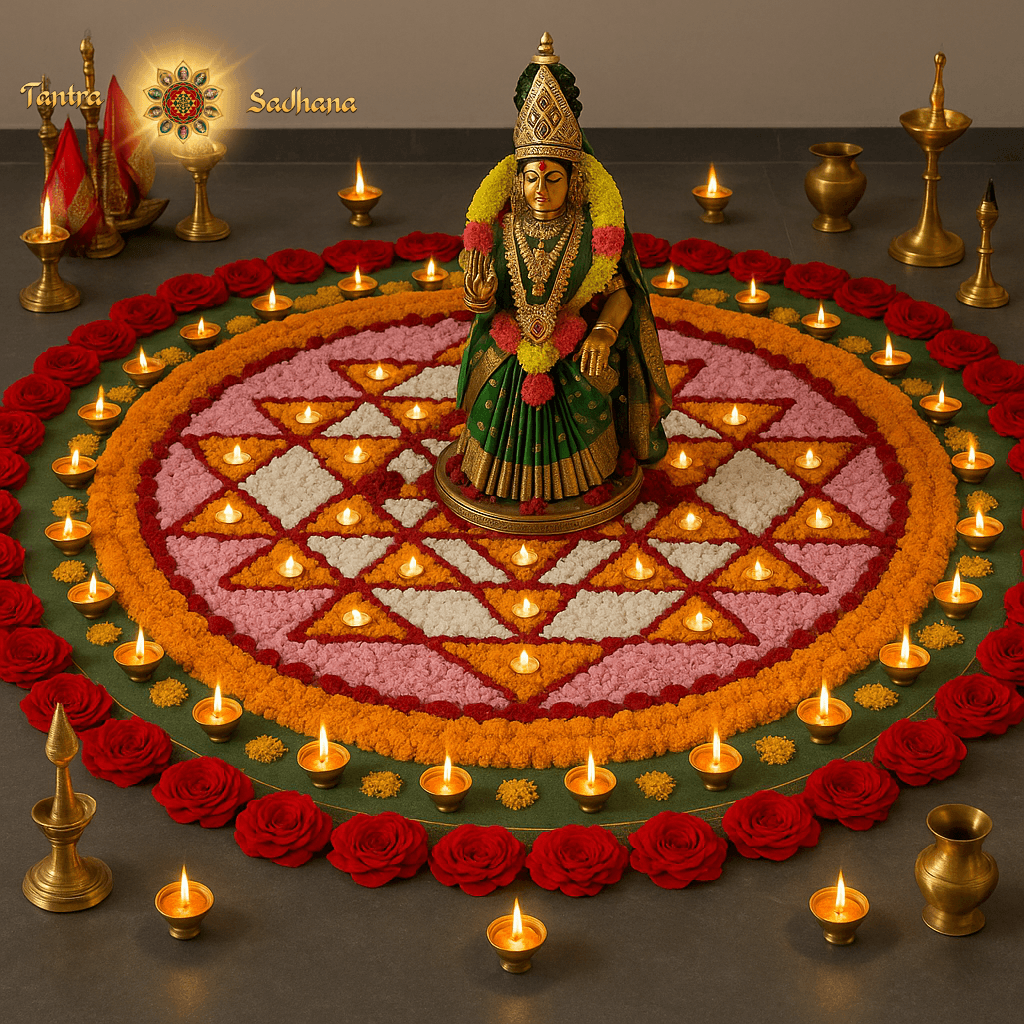
The Navavarana Puja, representing the systematic worship of the Sri Yantra's nine circuits, constitutes one of Sri Vidya's most sophisticated ritual practices. Beginning from the outermost square and progressing through each concentric layer toward the central bindu, practitioners engage in a symbolic journey from material awareness to divine consciousness. Each circuit corresponds to specific mantras, visualizations, and offerings that progressively refine the practitioner's spiritual faculties.
Traditional mantra practices accompanying yantra worship activate what practitioners describe as "awakened sound"—vibrational patterns that directly influence consciousness and energy. The most potent of these mantras, the Panchadasi and Shodashi, are traditionally transmitted only through proper initiation, ensuring the practitioner receives not merely the syllables but the spiritual transmission that activates their transformative power.
First Avarana: Bhupura - The Earth Foundation (Trilokya Mohana Chakra)
The Sri Yantra's outermost boundary consists of three concentric square lines forming the Bhupura (Earth Stretch), known as Trilokya Mohana Chakra—the "Enchanter of the Three Worlds." This foundational enclosure represents the devotee's initial entry into sacred space and governs the physical realm of existence.
The Divine Inhabitants: This avarana houses twenty-eight powerful deities arranged in three distinct lines. The outer rampart features ten Siddhi Devis.
Anima Sidhyamba | Power to become atomic-sized |
|---|---|
Laghima Sidhyamba | Power of extreme lightness |
Mahima Sidhyamba | Power of infinite expansion |
Ishitva Sidhyamba | Divine lordship |
Vasitva Sidhyamba | Complete control over elements |
Prakamya Sidhyamba | Fulfillment of desires |
Bhukti Sidhyamba | Enjoyment of all pleasures |
Ichha Sidhyamba | Supreme willpower |
Prapti Sidhyamba | Obtainment of anything desired |
Sarvakama Sidhyamba | Fulfillment of all wishes |
The middle rampart houses eight Matrika Devis (Mother Goddesses) who govern emotional transformation: Brahmi (passionate longing), Maheshwari (violent anger), Kaumari (avarice), Vaishnavi (righteousness), Varahi (obstinacy), Mahendri (pride), Chamunda (destructive emotions), and Mahalakshmi (abundance).
Brahmi Matruka | Governs passionate longing |
|---|---|
Maheshwari Matruka | Controls violent anger |
Kaumari Matruka | Manages avarice |
Vaishnavi Matruka | Regulates righteousness |
Varahi Matruka | Transforms obstinacy |
Mahendri Matruka | Controls pride |
Chamunda Matruka | Destroys negative emotions |
Mahalakshmi Matruka | Bestows abundance |
The inner rampart contains ten Mudra Devis of red complexion who rule sacred gestures and spiritual attainments.
Sarvasankshobhini Devi | Universal Agitator |
|---|---|
Sarvavidravini Devi | Universal Disperser |
Sarvakarshini Devi | Universal Attractor |
Sarvavashankari Devi | Universal Subjugator |
Sarvonmadini Devi | Universal Intoxicator |
Sarvamahankusha Devi | Universal Great Goad |
Sarvakhechari Devi | Universal Sky-Walker |
Sarvabeeja Devi | Universal Seed |
Sarvayoni Devi | Universal Source |
Sarvatrikhanda Devi | Universal Three-Part |
Presiding Consciousness: Tripura governs this realm, embodying divine power over the three worlds, while Prakata Yogini (Manifest Yogini) serves as the ruling spiritual guide.
Second Avarana: Shodasha Dala Padma - The Sixteen-Petaled Lotus (Sarvaasha Paripuraka Chakra)
The second enclosure manifests as a magnificent sixteen-petaled lotus called Sarvaasha Paripuraka Chakra—the "Fulfiller of All Desires." This realm governs the systematic satisfaction of legitimate wants as a prerequisite for spiritual advancement.
The Sixteen Nitya Kalas: Each petal houses one of the sixteen Nitya Devis (Eternal Goddesses), also called Akarshana Devis (Attraction Goddesses). These red-complexioned deities each hold a noose, goad, pot of nectar, and display the abhaya mudra (fear-dispelling gesture). They correspond to the sixteen Sanskrit vowels and govern specific aspects of desire fulfillment:
Kamakarshini Shakti | Attracts desires |
|---|---|
Budhyakarshini Shakti | Attracts intellect |
Ahankarakarshini Shakti | Attracts ego |
Shabdakarshini Shakti | Attracts sound |
Sparshakarshini Shakti | Attracts touch |
Rupakarshini Shakti | Attracts form/sight |
Rasakarshini Shakti | Attracts taste |
Gandhakarshini Shakti | Attracts smell |
Chittakarshini Shakti | Attracts consciousness |
Dhairyakarshini Shakti | Attracts steadiness |
Smrityakarshini Shakti | Attracts memory |
Namakarshini Shakti | Attracts name/identity |
Bijakarshini Shakti | Attracts seed potential |
Atmakarshini Shakti | Attracts soul |
Amritakarshini Shakti | Attracts nectar/immortality |
Sharirakarshini Shakti | Attracts physical body |
Presiding Consciousness: Tripureshi (Empress of Three Cities) governs this domain, depicted as magnificently ornamented, carrying a book and rosary. Gupta Yogini (Secret Yogini) serves as the ruling guide, representing hidden spiritual knowledge.
Third Avarana: Ashta Dala Padma - The Eight-Petaled Lotus (Sarva Sankshobhana Chakra)
The third enclosure forms an eight-petaled lotus known as Sarva Sankshobhana Chakra—the "Agitator of All." This realm governs the subtle mental pleasures that transcend physical dependencies, representing the refinement of desire into spiritual aspiration.
The Eight Ananga Devis: Each petal contains goddesses with the color of Bandhuka flowers, representing the eight aspects of Ananga (bodiless Cupid) governing mental pleasure.
Ananga Kusuma Shakti | Cupid's Flower Power |
|---|---|
Ananga Mekhala Shakti | Cupid's Girdle Power |
Ananga Madana Shakti | Cupid's Intoxication Power |
Ananga Madanatura Shakti | Cupid's Supreme Intoxication |
Ananga Rekha Shakti | Cupid's Line Power |
Ananga Vegini Shakti | Cupid's Swift Power |
Anangankusha Shakti | Cupid's Goad Power |
Ananga Malini Shakti | Cupid's Garland Power |
Presiding Consciousness: Tripura Sundari (Beautiful Goddess of Three Cities) presides here, depicted swaying in love-intoxicated bliss with eyes full of divine ecstasy. Guptatara Yogini (Secret Star Yogini) serves as the guide.
Fourth Avarana: Chaturdasha Trikona - The Fourteen Triangles (Sarva Soubhagyadayaka Chakra)
The fourth enclosure consists of fourteen triangles arranged in a complex geometric pattern, known as the Sarva Soubhagyadayaka Chakra—the "Bestower of All Prosperity." This realm governs the fourteen primary nadis (energy channels) in the human body, as well as their corresponding divine powers.
The Fourteen Prosperity Goddesses: These deities preside over fundamental consciousness powers and vital energy distribution.
Sarvasamkshobhini Devi | She Who Agitates All |
|---|---|
Sarvavidravini Devi | She Who Disperses All |
Sarvakarshini Devi | She Who Attracts All |
Sarvaahladini Devi | She Who Delights All |
Sarvasammohini Devi | She Who Fascinates All |
Sarvasthambhini Devi | She Who Paralyzes All |
Sarvajrumbhini Devi | She Who Expands All |
Sarvavashankari Devi | She Who Subjects All |
Sarvaranjani Devi | She Who Pleases All |
Sarvonmadini Devi | She Who Intoxicates All |
Sarvarthasadhika Devi | She Who Accomplishes All Objects |
Sarvasampattipurani Devi | She Who Fills With All Wealth |
Sarvamantramayi Devi | She Who Embodies All Mantras |
Sarvadwandwakshayankari Devi | She Who Destroys All Dualities |
Sacred Breath Distribution: This avarana relates explicitly to the breath distribution system, where the 21,600 daily breaths are distributed among the seven chakras according to precise time intervals, with the navel point serving as the distribution hub for all life force circulation.
Presiding Consciousness: Tripura Vasini with Sampradaya Yogini
Fifth Avarana: Bahir Dasara - The Outer Ten Triangles (Sarvartha Sadhaka Chakra)
The fifth enclosure contains the outer ten triangles that form the Sarvartha Sadhaka Chakra—the "Accomplisher of All Objects." This realm governs the ten vital forces (pranas) active in the body and their corresponding divine manifestations.
The Ten Vital Force Goddesses: These deities, with the luster of Japa flowers, govern the ten pranas essential for body function.
Sarva Siddhi Prada Devi | Governs Prana (respiration) |
|---|---|
Sarva Sampath Prada Devi | Governs Apana (elimination) |
Sarva Priyamkari Devi | Governs Vyana (circulation) |
Sarva Mangala Karini Devi | Governs Udana (speech/voice) |
Sarva Kama Prada Devi | Governs Samana (digestion) |
Sarva Duhkha Vimochini Devi | Governs Naga (belching) |
Sarva Mrityu Prashamani Devi | Governs Kurma (eyelid movement) |
Sarva Vighnanivarini Devi | Governs Krikara (sneezing) |
Sarva Jwara Vinashini Devi | Governs Devadatta (yawning) |
Sarva Roga Nivarini Devi | Governs Dhananjaya (final life force) |
Presiding Consciousness: Tripura Shri with Kulotteerna Yogini
Sixth Avarana: Antar Dasara - The Inner Ten Triangles (Sarva Rakshakara Chakra)
The sixth enclosure comprises the inner ten triangles known as Sarva Rakshakara Chakra—the "Protector of All." This realm governs the ten vital fires within the body and marks the beginning of advanced inner realization.
The Ten Protective Fire Goddesses: These deities shine like a thousand rising suns, governing the ten digestive fires essential for physical and spiritual transformation.
Sarvagya Devi - Rechak Agni (Fire of Purgation) | Omniscient Goddess |
|---|---|
Sarvashakti Devi - Pachak Agni (Fire of Digestion) | All-Powerful Goddess |
Sarvaswaryapradayini Devi - Shoshak Agni (Fire of Absorption) | Granter of All Wealth |
Sarvagyanamayi Devi - Dahak Agni (Fire of Burning) | Embodiment of All Knowledge |
Sarvavyadhinivarini Devi - Plavak Agni (Fire of Secretion) | Remover of All Diseases |
Sarvadharaswarupa Devi - Ksharak Agni (Fire of Acidification) | Supporter of All |
Sarvapapahara Devi - Uddharak Agni (Fire of Excretion) | Remover of All Sins |
Sarvanandamayi Devi - Kshobhak Agni (Fire of Agitation) | Embodiment of All Bliss |
Sarvarakshaswarupini Devi - Jrambhak Agni (Fire of Assimilation) | Protector Form |
Sarvepsitaphalaprada Devi - Mohak Agni (Fire of Attraction) | Granter of Desired Fruits |
Presiding Consciousness: Tripura Malini with Nigarbha Yogini
Seventh Avarana: Ashtakona - The Eight Triangles (Sarva Rogahara Chakra)
The seventh enclosure forms an eight-cornered figure known as the Sarva Rogahara Chakra—the "Destroyer of All Disease." This realm governs the eight fundamental contradictions in existence and the eight speech goddesses who rule all Sanskrit letter groups.
The Eight Vasini Goddesses: These deities, characterized by pomegranate flower coloration, each carry five arrows and a bow, representing their mastery over the five senses. They govern the eight Sanskrit letter groups and fundamental dualities.
Vasini Vagdevi | Goddess of Compelling Speech (Ka group letters) |
|---|---|
Kameswari Vagdevi | Goddess of Desirable Speech (Cha group letters) |
Modini Vagdevi | Goddess of Delightful Speech (Ta group letters) |
Vimala Vagdevi | Goddess of Lotus Speech (Ta group letters) |
Aruna Vagdevi | Goddess of Dawn Speech (Pa group letters) |
Jayini Vagdevi | Goddess of Victorious Speech (Ya group letters) |
Sarveswari Vagdevi | Goddess of Supreme Speech (Sha group letters) |
Koulini Vagdevi | Goddess of Silk-like Speech (Ksha group letters) |
Presiding Consciousness: Tripura Siddha with Rahasya Yogini
Eighth Avarana: Trikona - The Primary Triangle (Sarva Siddhiprada Chakra)
The eighth enclosure comprises the innermost triangle, known as Sarva Siddhiprada Chakra—the "Bestower of All Accomplishments." This primary triangle, independent of all intersecting lines, represents the Kama Kala—the fundamental creative energy that bridges formless consciousness and manifest creation.
The Trinity of Supreme Goddesses: This triangle houses the three most fundamental manifestations of divine consciousness.
Kameshvari ( Rudra Shakti) | Appears pure white, like camphor, adorned with pearls and crystals, holding a book and rosary while displaying boon-granting and fear-removing mudras. She governs the moon principle (creation aspect), embodies Pashyanti (visionary speech), and represents Iccha Shakti (will power) |
|---|---|
Vajreshi (Vishnu Shakti) | Manifests bright red like kumkuma powder, adorned with flowers and gems, holding a sugarcane bow and five flowery arrows. She governs the sun principle (preservation aspect), embodies Madhyama (intermediate speech), and represents Jnana Shakti (knowledge power) |
Bhagamalini (Brahma Shakti) | Radiates fiery golden light, embodying divine creative power. She governs the fire principle (dissolution aspect), embodies Vaikhari (articulated speech), and represents Kriya Shakti (action power). |
Presiding Consciousness: Tripuramba (Sampatprada Bhairavi) with Ati Rahasya Yogini
The Ninth Avarana: Sarvanandamaya Chakra - Bindu
The ninth and final avarana transcends the concept of enclosure entirely—it is the Bindu, the dimensionless central point, called the Sarvanandamaya Chakra, the "All-Blissful Chakra." This represents the ultimate destination of spiritual practice and the source of all manifestation.
The Supreme Presence: Here resides Her Transcendent Majesty Lalita Maheshwari Mahatripurasundari, also known as Rajarajeshwari (Empress of Emperors). She represents the personification of Brahman itself—beyond all attributes yet encompassing all qualities, the eternal union of Shiva (pure consciousness) and Shakti (divine energy) in perfect harmony.
Mystical Significance: The Bindu embodies multiple paradoxes simultaneously—the smallest point containing infinite space, the silence containing all sound, the stillness containing all movement. It represents Sarvanandamaya consciousness resting in its own nature, the mathematical and mystical origin from which all creation emerges and to which it returns.
Ultimate Realization: Advanced practitioners describe reaching the Bindu as experiencing bindu visarga—the direct realization that individual consciousness and universal consciousness are fundamentally identical. This represents the culmination of Sri Yantra practice: the dissolution of the practitioner-yantra-practice triad into pure, undifferentiated awareness.
The Mantras for Worshipping the Sri Yantra
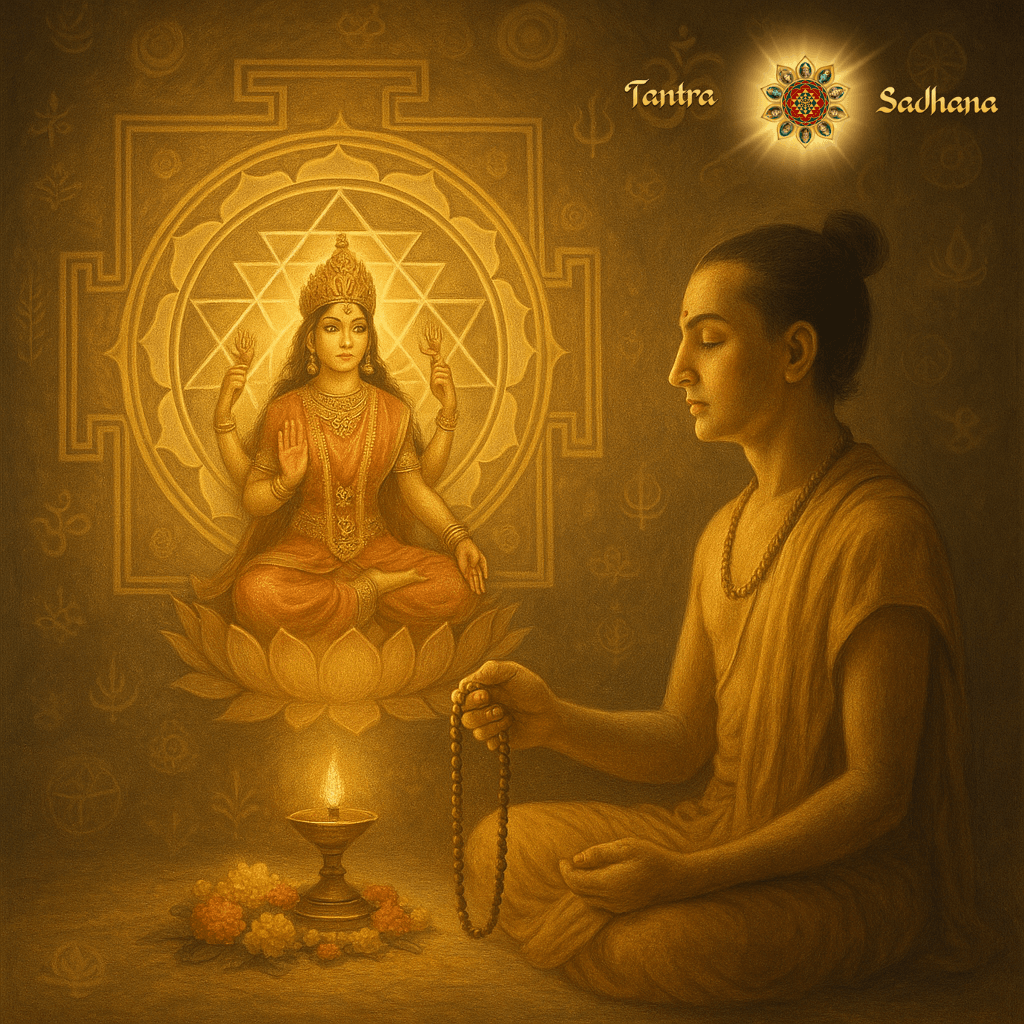
In the profound tradition of Sri Vidya and Sri Yantra worship, mantras serve as the sacred sound vehicles that activate, energize, and invoke the divine presence. Central to this practice are six pivotal mantras—the Bala Mantra, Panchadashi Mantra, Shodashi Mantra, Sri Devi Khadgamala Stotra, Lalitha Sahasranama, and Lalitha Trisathi—each playing a unique and interconnected role in facilitating spiritual transformation and divine communion.
Bala Mantra
The Bala Mantra serves as the foundational gateway to Sri Vidya practice, representing the "kindergarten" stage of this profound spiritual system. This mantra invokes Sri Bala Tripurasundari, the child form of the Great Goddess who embodies infinite energy and awareness.
The mantra includes the Vagbhava Bija (speech seed), encompassing all four Vedas and their essence in the mahavakyas, symbolizing the foundation of spiritual knowledge. The mantra also includes the Kamaraja Bija, containing the complete 36 tattvas (cosmic principles). It represents the creative force that bridges consciousness and manifestation. Finally, the mantra includes a bija that provides protection and fulfillment while sealing the mantra's transformative power. Traditional texts describe this mantra as awakening awareness of one's unlimited energy, making practitioners conscious of their infinite potential.
Panchadashi Mantra
The Panchadashi Mantra represents the supreme fifteen-syllabled invocation of Goddess Tripura Sundari, embodying the complete essence of Sri Vidya philosophy. This mystical formula contains within its structure the fundamental aspects of divine feminine consciousness organized into three sacred sections called kutas (peaks).
The Vagbhava Kuta represents knowledge, speech, and the power of creation, corresponding to Brahma Shakti. The Kamaraja Kuta embodies desire, will, and the sustaining force, representing Vishnu Shakti. The Shakti Kuta signifies action, transformation, and the power of dissolution, corresponding to Rudra Shakti. Together, these three kutas form the complete trinity of manifestation - knowledge, desire, and action.
Each syllable functions as a bija (seed sound) charged with divine vibration rather than literal meaning, representing the union of Shiva and Shakti at the deepest level. The Panchadashi is considered a siddha mantra, carrying its own inherent power, although initiation significantly enhances its potency.
Shodashi Mantra
The Shodashi Mantra represents the most secret and powerful sixteen-syllabled invocation in Hindu tradition, extending the Panchadashi with additional transformative elements.
The crucial addition of the Sri Bija transforms the fifteen-syllabled Panchadashi into the supremely powerful Shodashi, specifically invoking the auspiciousness and abundance of Goddess Lakshmi. This bija promotes positive attitude, faith, devotion, love, and ultimate surrender, leading directly to liberation.
Traditional texts emphasize the mantra's extraordinary secrecy with the declaration:
Rajyam deyam siro deyam na deyam Sri Sodasakshari
— Give away your empire or even your head, but never reveal the Sodasakshari mantra.
The mantra's power equals all sixty-four other mantras combined, making it the supreme sound formula for spiritual liberation.
Sri Devi Khadgamala Stotra
The Sri Devi Khadgamala Stotra serves as the "garland of swords" prayer, systematically invoking all 108 deities residing within the nine sacred enclosures of the Sri Yantra. "Khadga" means sword, "Mala" means garland, representing the Devi's power to destroy desire, hatred, and delusion through her protective weapons of divine knowledge. This stotra guides practitioners on a mental journey through the complete Sri Chakra structure, beginning with the outermost Bhupura and progressing through each avarana toward the central bindu, where the Goddess Kameshwari resides in cosmic union. The prayer systematically names the 16 Nityas (eternal goddesses corresponding to the lunar phases), the various Yoginis, Mudra Devis, Siddhi Devis, and all other divine forces that govern each geometric section.
The Khadgamala Stotra originates from the Vamakeshvara Tantra as a dialogue between Uma and Maheshvara, establishing its authentic tantric lineage. Reciting this stotra is said to bestow the complete benefits of performing the elaborate Sri Chakra Navavarana Puja, making the complete ritual accessible through sound alone. The practice fosters internal alignment with each deity's unique power, gradually preparing practitioners to internalize these divine qualities and ultimately merge with the supreme goddess at the center of the Yantra.
Lalitha Sahasranama
The Lalitha Sahasranama comprises the thousand sacred names of Goddess Lalitha Tripurasundari, as found in the Brahmanda Purana, representing one of Hinduism's most revered devotional texts. Each name describes a specific attribute, quality, or cosmic function of the Divine Mother, serving as a complete catalog of divine feminine consciousness and its infinite manifestations.
Goddess Lalitha is not merely associated with the Sri Yantra; she is the Sri Yantra. Every geometric element corresponds to her divine aspects: the outer square represents her guardians, the three circles denote her cosmic play, the lotus petals symbolize her benevolent grace, the nine interlocking triangles represent the phenomena of creation, and the central bindu symbolizes her formless, infinite presence. The name "Sri Chakra Raja Nilaya" explicitly identifies her as dwelling within the Sri Chakra.
Lalitha Trisathi
The Lalitha Trisathi presents the 300 most sacred and secret names of Goddess Lalitha, considered even more powerful and esoteric than the Sahasranama. Found in the Brahmanda Purana, this stotra was revealed to Sage Agastya by Lord Hayagriva (Vishnu's knowledge avatar) at the direct behest of the goddess herself.
The Trisathi's unique construction follows the fifteen letters of the Panchadashi Mantra, with each letter generating twenty divine names, creating the complete collection of 300. This systematic organization means that each name functions not merely as a description but as a mantra - possessing esoteric spiritual meanings and generating powerful vibrational effects through recitation alone, even without conscious understanding of the meanings. Adi Shankaracharya's elaborate commentary reveals the profound, yet non-obvious, interpretations embedded within each name.
Das Mahavidyas and the Sri Yantra
The relationship between the Das Mahavidyas and the Sri Yantra represents one of Sanatana Dharma's most sophisticated spiritual achievements: the successful integration of diverse divine energies into a unified geometric system that serves both practical spiritual needs and ultimate transcendental realization.
The Sri Yantra is primarily associated with Tripura Sundari (also known as Lalita, Shodashi, or Rajarajeshwari), who is the third Mahavidya and considered the supreme deity of Sri Vidya tradition. However, this relationship extends far beyond a simple one-to-one correspondence. Traditional texts describe the Sri Yantra as the complete geometric representation of Tripura Sundari's cosmic form. Each of the nine avaranas (enclosures) corresponds to different aspects of her divine manifestation, with the central bindu representing her ultimate formless essence.
You can imagine the Sri Yantra as a cosmic parliament where all divine energies, including the ten Mahavidyas, have their designated places and functions. The manifestation of the goddess as Kali (transformative time), Tara (guiding star), Tripura Sundari (transcendent beauty), Bhuvaneshvari (cosmic sovereignty), Chinnamasta (self-sacrifice), Bhairavi (fierce grace), Dhumavati (wisdom in void), Bagalamukhi (paralyzing power), Matangi (inner wisdom), and Kamala (lotus prosperity) contributes specific energies that manifest through different aspects of the Sri Yantra's structure.
Worshipping the Sri Yantra using the Tantra Sadhana App

Now that you know so much about the Sri Yantra and the immense possibilities it offers you, the next logical question is, how can we begin worshipping the Sri Yantra? Can we set aside time from work and everyday responsibilities to begin this esoteric practice that has been closely guarded for thousands of years? Would it be safe to do it if you have not been physically initiated by a Guru? These are natural questions any seeker may have.
Sanatana Dharma has always been through various inflection points, and remarkable sages have guided and reshaped age-old practices to fit the needs of the times while preserving their sanctity. Maharishi Ved Vyasa compiled the Vedas in written form after they had been transmitted orally for centuries. Adi Shankaracharya challenged the ritualistic forms of worship that had taken over, blending principles of non-duality and devotion to forge a new direction. Swami Vivekananda recognized the need to preach Vedanta to the rest of the world. He crossed the seven seas to fulfill his guru's wish. It took many years for people to understand how their actions revolutionized and revitalized Sanatana Dharma.
The founder of the Tantra Sadhana app, Om Swami, is on a similar mission to revive Sanatana Dharma and ensure its esoteric practices are available to all sincere seekers. His birth was prophesied by a saint who gave his mother, Matarani, the following message.
In the month of Margashirsha, when the moon is waxing, you will give birth to a special soul. One of us is coming after a very long wait—a saint.
On 30th November 1979, Om Swami graced this world on the twelfth night of the waxing moon. He was eleven when he began learning Vedic Chanting, astrology, and performing havans at home. He meditated in isolated places, performed numerous yagnas, chanted various mantras, practiced sadhanas of various divine entities, and even undertook a tantric Sadhana of Lord Shiva. He then mastered computer coding and founded a multi-million dollar software company in Australia. He accomplished all this while continuing to practice hours of sadhana and meditation every day. In 2007, he felt he was now fully ready to renounce the world and immerse himself entirely in the search for the divine. He told his mother about his plans and asked for her permission, as he wanted to dedicate all his energy to pursuing a sustained vision of God. His single-minded focus on discovering the truth about the existence of God, studying the Vedas, and practicing Sadhanas culminated in his divine visions of both Devi and Lord Vishnu. After returning from the Himalayas, Swamiji devoted his life to finding a way to transmit the sadhana he had performed, so that humanity could benefit from it.
Om Swami recently launched the Tantra Sadhana app, which constitutes a complete transmission system for awakened tantric practices traditionally available only through direct initiation. It provides access to awakened mantras of the Das Mahavidyas—the ten cosmic goddesses representing different aspects of divine consciousness. These mantras have been personally invoked and energized by Om Swami, ensuring practitioners receive not merely syllables but living spiritual transmissions capable of catalyzing genuine transformation. Immersive 3D environments recreate sacred spaces that support deep spiritual practice. Users can perform traditional Tantric rituals, including Shav Sadhana, Sri Yantra Sadhana, Khandada Munda Sadhana, Panch Mundi Sadhana, and sophisticated fire offerings (homas) with step-by-step guidance that maintains authenticity while adapting to contemporary circumstances. The app's progressive spiritual journey structure allows practitioners to advance systematically through increasingly sophisticated practices as their spiritual maturity develops. This approach honors the traditional guru-disciple relationship while making advanced teachings available to qualified seekers regardless of geographical limitations.
In our age of global connectivity and technological advancement, the Sri Yantra and the Tantra Sadhana app remind us that the most profound truths of existence remain accessible to anyone willing to engage seriously with the profound mysteries of sacred geometry and spiritual transformation.
References
- blog.vinitarashinkar.in - Comprehensive overview of Sri Yantra as the supreme yantra and its spiritual significance
- apps.apple.com - Official information about Om Swami's Tantra Sadhana app features and user testimonials
- mahaavidya.org - Detailed biography and contributions of Bhaskararaya to Sri Vidya systematization
- ramanisblog.in - Historical account of Adi Shankaracharya's Sri Yantra installation at Kamakshi temple
- forum.amritananda.org - Ramana Maharshi's personal experiences and teachings on Sri Yantra practice
- www.scribd.com - Complete mapping of 108 deities in the nine avaranas of Sri Yantra
- vedicvaani.com - Relationship between Das Mahavidyas and Sri Yantra worship practices
- astrobhava.com - Detailed explanation of Panchadasi mantra significance and benefits
- drpallavikwatra.com - Comprehensive analysis of Khadgamala Stotra and its role in Sri Yantra worship
- en.wikipedia.org - Foundational information about Sri Yantra's historical background and traditional descriptions

